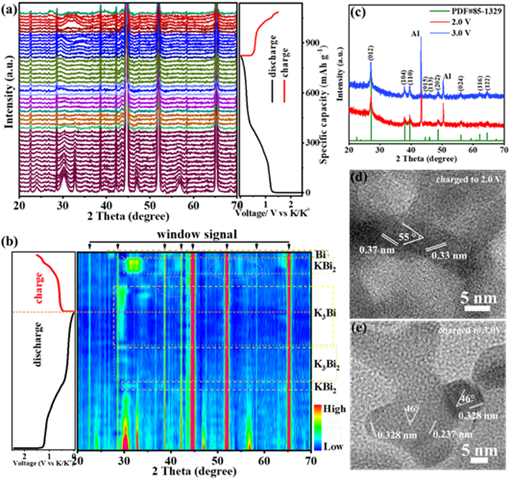Recently, professor Xu Liqiang' group in Qian Yitai team from School of Chemistry and Chemical Engineering made an advance in the development of anode materials for potassium ion batteries (PIBs). Related research results was published online in Angewandte Chemie International Edition (2021, DOI: 10.1002/anie.202100654; IF: 12.99), titled “In-situ Nano-Crystallization and Solvation Modulation Promote Highly Stable Anode Involving Alloy/De-alloy for Potassium Ion Batteries”, where Ph.D candidate Wang Lu is the first author and his supervisor Professor Xu Liqiang from School of Chemistry and Chemical Engineering of Shandong University (the first corresponding author institute) is the solo corresponding author.

The limited and uneven-distribution of lithium resource have urged the development of energy storage devices including new-type advanced secondary ion batteries, among which PIBs have gained increasing attention due to the favorable working-voltage of potassium metal anode, high reserve of potassium, etc. However, the highly reactivity of potassium metal has raised the requirement for stable anode materials with high performance. Comparing with the widely reported carbon based materials, anode materials processing alloy/de-alloy electrochemistry, represented by bismuth-containing materials, have been one of the concerned hotspots, benefiting from their high theoretical capacity and relatively safe working-voltages, while those materials are challenged by the fast capacity decay and limited life-span resulted from the volume effect during potassiation/depotassiation. Thus, research concerning the stability of the materials those involve alloy/de-alloy electrochemistry needs to be expanded, and understanding of the working mechanism of involving factors also needs to be broadened.

Aiming to improve the energy storage, exchange efficiency and the long-term cycling stability of PIBs, Xu Liqiang' group firstly reported a new anode material of (BiO)2CO3, whose two-dimensional structure with a large lattice spacing of 0.683 nm was adopted to enable smooth insertion/de-insertion of the large-sized K+, which endowed an in-situ nano-crystallization of the (BiO)2CO3, and accordingly endowed structural stability of the integrated (BiO)2CO3particles, from the aspect of individual anode materials. Additionally, a concentrated KFSI-G2 electrolyte was developed based on solvation modulation of KFSI, to construct an inorganic-component rich SEI film on the (BiO)2CO3electrode, which was designed to make a high-efficient and stable interface between electrode and electrolyte. The synergistic effect between improvement of both structural stability and interfacial stability enabled the (BiO)2CO3electrode to achieve a high specific capacity of 610 mAh g-1at a current density of 0.025 A g-1; more noticeably, a highly stable cyclic performance was achieved for 1500 cycles at 0.2 A g-1with a low decay rate of 0.007%. Furtherly, the potassiation/depotassiation mechanism was conveyed based on characterizations of in-situ XRD and ex-situ HRTEM, etc., and the success of full-cell coupled with PTCDA cathode and pouch cell further verified the highly potential of (BiO)2CO3as anode materials for practical application of PIBs. This work broadens the application of bismuth-containing materials, and could provide theoretical and experimental references for the development of alloy/de-alloy electrochemistry involved anode materials that are desired to possess high performance and high stability. The chemistry involved in the interphase between electrode and electrolyte could also provide new sight for science in the secondary potassium ion batteries.
Professor Xu Liqiang' group mainly focus on the development of electrode materials and target to propel the high efficient energy storage and conversion devices including secondary potassium/sodium ion batteries, and lithium-sulfur batteries, and have made serial and systematic works involving synthesis of electrode materials, surface and interface regulations, mechanism investigations, and their preliminary applications in energy storage and conversion. In addition to the (BiO)2CO3work above, some works have also been published inEnergy Storage Mater.(IF: 16.28), 2020, 25, 679-686;Appl. Catal. B: Environ.(IF:16.683), 2020, 175, 119104;ACS Energy Lett.(IF: 19.003),2019,4, 1496-1504;Energy Storage Mater.(IF: 16.28), 2019, 23, 35-45;ACS Nano(IF: 14.588), 2018, 12, 8277-8287;Energy Storage Mater.(IF: 16.28), 2018,15, 234-241, etc. A second prize of natural science in Shandong province was awarded in 2020 for the achievement above. The website of professor Xu's group is athttps://faculty.sdu.edu.cn/~fI3Iry/zh_CN/index.htm.
The serial works have been funded by the National Natural Science Foundation of China, the National Natural Science Foundation of Shandong province, Interdisciplinary Foundation of Shandong University, and supported by the structure composition and physical property characterization platform of SDU.
Weblink of the article:https://onlinelibrary.wiley.com/doi/10.1002/anie.202100654.